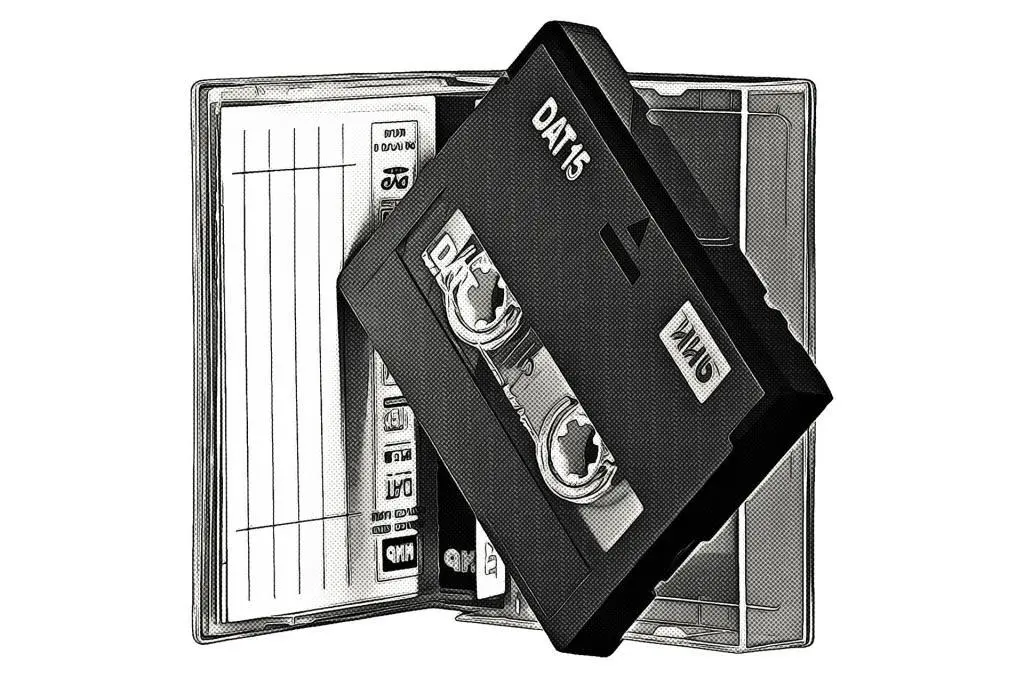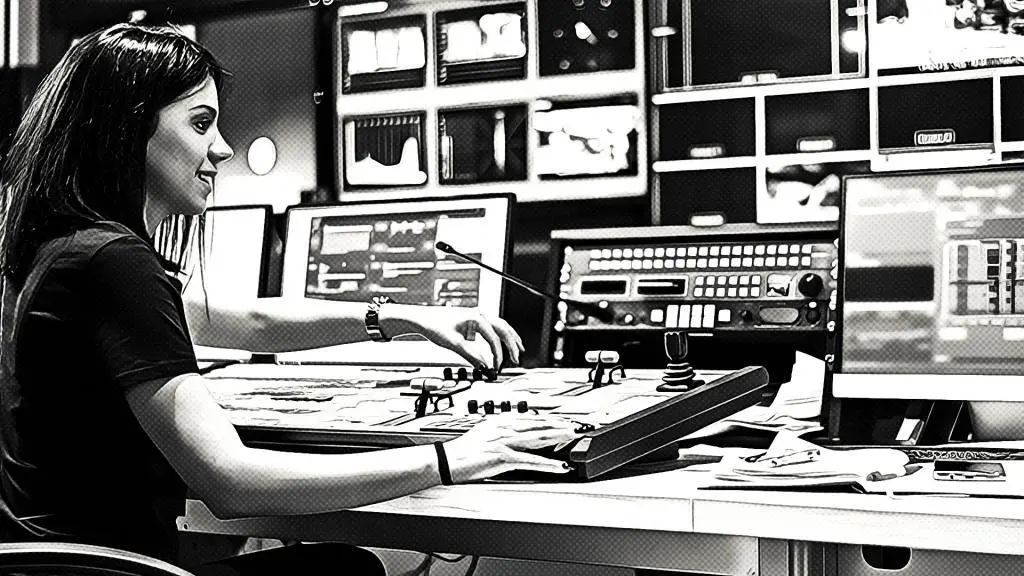Digital Audio Tape or simply put, DAT, is a signal recording and playback standard medium. DAT was developed by Sony and introduced in 1987. Digital Audio Tape has become the standard recording and archiving technology in professional recording environments for master recordings. The technology is based on video recorders and the 4 mm tape and also the rotary head configuration is closely similar to 8 mm from Sony.

What is DAT: Table of Contents
What is DAT? More on Digital Audio Tape
Digital Audio Tape (DAT or R-DAT) is a magnetic tape format used for digital audio recording and playback. It was introduced in the mid-1980s and was primarily used in professional audio recording and mastering applications. In this article, we will explore the technical characteristics, applications, and importance of DAT tapes in the audio industry, as well as how to preserve and maintain them for future generations.
What are Specifications of Digital Audio Tapes?
DAT tapes are similar in appearance to analog audio cassette tapes, but they use a different type of tape and recording format. DAT tapes use a narrow, 4mm-wide tape coated with a magnetic material that can record digital audio at a high resolution. Here are some of the physical characteristics of DAT tapes:
- Tape width: 4mm
- Length of tape: up to 120 meters
- Tape speed: 8.15 mm/s
- Number of tracks: 2 (for stereo recording)
- Tape thickness: 0.00185 inches (47 microns)
What is the Recording Format of DAT?
DAT tapes can store up to 120 minutes of stereo audio with a sampling rate of 48 kHz and a resolution of 16 bits. The digital audio data is recorded as a series of 0′s and 1’s on the tape using a helical-scan recording method. This means that the tape is wrapped around a rotating drum that has multiple heads, which write and read the data from the tape at an angle.
DAT tapes use a type of error correction called Cross-Interleaved Reed-Solomon Code (CIRC) to detect and correct errors in the data. This ensures that the recorded audio is free from dropouts and other types of data loss.
DAT tapes also have a subcode area, which can store additional information such as track markers, timecode, and other metadata. This information is used during playback to locate specific parts of the audio recording.
Advantages and Disadvantages of DAT Tapes
One of the main advantages of DAT tapes is their high audio quality. DAT tapes can record audio at a high resolution and with low levels of noise, making them ideal for professional audio applications. They are also relatively inexpensive compared to other professional recording formats like reel-to-reel tape.
However, there are also some disadvantages to using DAT tapes. One of the main issues with DAT tapes is their susceptibility to dropouts and other types of data loss. This can be caused by factors like tape wear, dust and debris on the tape heads, and other types of physical damage. DAT tapes are also relatively fragile and can easily break or become damaged if not handled properly.
Applications of DAT Tapes

DAT tapes were used for a wide range of professional audio applications, including studio recording, broadcast, and live sound reinforcement. Here are some of the main applications of DAT tapes:
Studio Recording and Mastering
One of the main uses of DAT tapes was in professional recording studios for the recording and mastering of music and other types of audio. DAT tapes allowed for high-quality digital recordings that could be edited and mixed using digital audio workstations (DAWs). DAT tapes also provided a more compact and cost-effective solution compared to other professional recording formats like reel-to-reel tape.
Broadcast Applications
DAT tapes were also used for broadcast applications, such as for the recording and playback of radio programs, news broadcasts, and other types of audio content. DAT tapes provided a high-quality and reliable solution for broadcasters, as well as a more affordable alternative to other broadcast formats like MiniDisc.
Live Sound Reinforcement and Recording
DAT tapes were also used in live sound reinforcement and recording applications. Live sound engineers used DAT tapes to record and archive live performances, as well as for playback during concerts and other live events. DAT tapes provided a reliable and portable solution for recording and playback in live sound environments.
Comparison with Other Audio Formats
While DAT tapes were popular in the professional audio industry during the 1990s and early 2000s, they eventually became replaced by other digital audio formats. Here are some of the main differences between DAT tapes and other audio formats:
Analog Tape Formats
Before the introduction of DAT tapes, most professional audio recordings were made using analog tape formats like reel-to-reel tape. Analog tape has a different sound quality and character compared to digital audio, which some people prefer. However, analog tape is also more prone to degradation and wear over time, which can affect the sound quality.
Digital Audio Formats (CD, MP3, etc.)
After the introduction of DAT tapes, other digital audio formats like CD and MP3 became more popular for consumer and professional use. These formats are more convenient and cost-effective compared to DAT tapes, as they do not require any special hardware or software for playback. However, they also have lower audio quality compared to DAT tapes and are more prone to data loss and other issues.
Preservation and Maintenance of DAT Tapes
As with any type of magnetic tape, DAT tapes require proper storage and maintenance in order to preserve their audio quality and longevity. Here are some tips for preserving and maintaining your DAT tapes:
- Store your DAT tapes in a cool, dry, and dark place away from direct sunlight and moisture. Avoid storing them in places where they may be exposed to extreme temperatures or humidity.
- Handle your DAT tapes with clean hands and avoid touching the tape or tape heads. Use a soft-bristled brush to clean the tape heads if they become dirty or dusty.
- Use high-quality tape decks and other hardware for playback and recording. Avoid using old or poorly maintained equipment, as this can cause damage to your DAT tapes and affect the audio quality.
- Make backups of your DAT tape recordings to other digital formats, such as WAV or FLAC files. This ensures that you have a digital copy of your recordings in case of any issues with the original tape.
FAQs: Answering the Top Questions about DAT
In this section, you can find brief responses to the most common inquiries regarding DAT that have been submitted through the search bar. As new questions are received, this section will be updated regularly.
What does DAT stand for?
DAT as a a type of magnetic tape used for digital audio recording and storage is an abbreviation for Digital Audio Tape.
Who developed Digital Audio Tape (DAT) and in what year was it introduced?
DAT was developed by Sony and introduced in 1987.
Can a DAT cassette be recorded and played in both directions?
Yes, a DAT cassette can be recorded and played in both directions, allowing for bi-directional recording and playback.
What is sticky-shed syndrome?
Sticky-shed syndrome is a problem that can occur with older DAT tapes, where the binder that holds the magnetic particles to the tape base can break down and become sticky, causing the tape to stick to the tape heads and become unusable.
What was the technology behind DAT based on?
The technology behind DAT is based on pulse-code modulation (PCM), a method of digitally encoding analog audio signals.
What are the four sampling modes allowed by the DAT standard?
The four sampling modes allowed by the DAT standard are 32 kHz, 44.1 kHz, 48 kHz, and 96 kHz, with 16-bit or 20-bit resolution.
What is Digital Compact Cassette (DCC) and how does it compare to other digital tape recording systems?
Digital Compact Cassette (DCC) was a digital audio recording format introduced by Philips and Matsushita in the 1990s. It used magnetic tape to record digital audio, and offered several advantages over analog cassette tapes, including better sound quality, longer playing time, and the ability to skip tracks. Compared to other digital tape recording systems, such as Sony’s Digital Audio Tape (DAT) and Sony’s MiniDisc, DCC was more similar to traditional cassette tapes in terms of size and appearance, and was marketed as a direct replacement for analog cassette tapes.
What was the opposition of the Recording Industry Association of America (RIAA) against the introduction of DAT devices into the U.S.?
The Recording Industry Association of America (RIAA) opposed the introduction of Digital Audio Tape (DAT) devices into the U.S. market because they were concerned about the potential for widespread copyright infringement. The RIAA feared that consumers would use DAT devices to make perfect digital copies of music recordings, which could then be distributed illegally. As a result of the RIAA’s opposition, the U.S. government placed restrictions on the sale and use of DAT devices.

